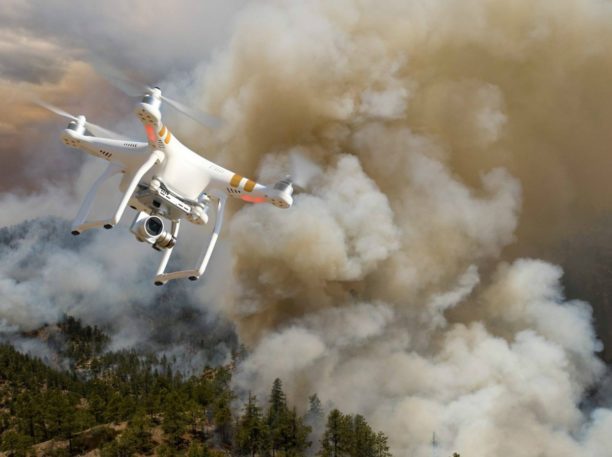A Conversation on Public Safety UAS – Information You Don’t Want to Miss
By: Dawn M.K. Zoldi, Guest Contributor
This year the DRONERESPONDERS non-profit started hosting a free monthly open-to-all public safety-focused webinar series titled “A Conversation on Public Safety UAS” hosted by Director Charles Werner, featuring Michael O’Shea, Program Manager with the Unmanned Aircraft System (UAS) Integration Office at the Federal Aviation Administration (FAA). Other FAA guests routinely join the duo.
You don’t need to be in public safety to benefit from this interactive and informative series.
This month featured Kerry Fleming of the FAA System Operations Support Center (SOSC), who discussed Special Government Interest (SGI) waivers for Part 107 small UAS operators and those operating under a Certificate of Waiver or Authorization (COA).
SGIs apply to time-critical life-saving flight unmanned aircraft system (UAS) operations that “cannot be done quickly or conveniently by any other means.” The FAA website lists some of those emergencies as including firefighting, search and rescue, law enforcement, utility or other critical infrastructure restoration, damage assessments supporting disaster recovery related insurance claims and media coverage providing crucial information to the public. These approvals can be life-and-death and are always fact-specific. For this reason, the SOSC is a 24 hours/7 days-a-week/365 days-a-year operation.
According to Kerry, his team works with a “get to yes” mindset. However, there are some ops that usually amount to a “no” under the SGI process:
- Training – training is almost never considered an emergency, even if good training might eventually save lives. The “time-critical” and “life-saving” requirements are a must.
- Routine maintenance – pre-planned critical infrastructure maintenance will normally not fall under the SGI process; however, if a node (e.g., power grid) could experience imminent failure and an inspection is required to prevent that, give the SOSC a call to work through it
- Non-imminent situations – if an expected event (e.g., anticipated tumultuous protest which could turn into a riot) is a week away, use the FAA’s DroneZone. If a fire is occurring right now, that’s a different story. A good rule of thumb is to ask yourself: is this occurring in the next hour or within a few hours?
- Blanket approvals for all crime scenes – this one’s a no go too. The reality is that air traffic control, other operators in the national airspace system (NAS) and the FAA all need to know who is in the airspace, where and when. Blanket approvals defeat this purpose because they are too generic. For example, a life flight helicopter pilot should be confident he/she will not encounter an UAS on their ascent or descent.
- Wide area approvals for extended durations – the FAA team asks that requests be reasonable. Kerry discussed one requester from the midwest during a recent snowstorm who asked for 90 square nautical miles of coverage. The “yes and” response was a collaborative work-around to create multiple and sequential approvals for smaller footprint areas.
The SOSC addresses issues on a case-by-case basis. Kerry advises, “Call us, tell us the situation and what you need. Let us figure out the airspace issues, talk to air traffic control and get it authorized and approved. We’ll try to do so as fast as humanly possible.” In fact, in some cases, the SOSC can get a verbal authorization, followed up with all the right paperwork, in as few as five minutes.
Exactly what that paperwork will look like will depend on the situation. Kerry explained that the SOSC can facilitate emergency UAS operations over people or at night for Part 91 COA-holders. They can also assist with an SGI involving tactical beyond visual line of sight (TBVLOS) for Part 107 users, allowing for flights out to 1500 feet and flown under 50 feet above ground level. Beyond visual line of sight (BVLOS) ops are a possibility as well. Kerry elaborated, “BVLOS means its a larger area, so we will need to issue a temporary flight restriction (TFR) to protect the airspace.”
TFRs can only be requested by national defense, national security, and federal intelligence departments and agencies. However, other government or private sector entities can request those agencies to sponsor a TFR over critical locations. The federal sponsor will need to do a threat matrix to help the FAA determine if a TRF is appropriate. If it is, the sponsored party will need an SGI to fly within that TFR. TFRs are typically ongoing, such as in the case of the recent western wildfires and hurricanes in the south.
For more information on the SGI process, check out the FAA’s SGI Handbook and the Public Safety and Small Drone Playbook. For general UAS questions, start with the FAA’s Help Center; contact the SOSC with specifics. Of course, the DRONERESPONDERS website is also chock full of information. To untap these and other helpful resources, join DRONERESPONDERS. Memberships are free and also open to all.
Great references to have on hand include FAA Joint Order (JO) 7200.23B, Processing of Unmanned Aircraft Systems Requests, Advisory Circular (AC) 91-63D, Temporary Flight Restrictions and Flight Limitations and for public aircraft operators (including those working with contractors) AC 00-1.1B, Public Aircraft Operations—Manned and Unmanned Document Information.
DRONERESPONDERS webinars are videotaped for later review; registration is required for the live events. The next one will occur on Apr 14, 2021 at 4:00pm EST U.S. Plug into this worthwhile series now! For questions, contact: info@droneresponders.org.
Miriam McNabb is the Editor-in-Chief of DRONELIFE and CEO of JobForDrones, a professional drone services marketplace, and a fascinated observer of the emerging drone industry and the regulatory environment for drones. Miriam has penned over 3,000 articles focused on the commercial drone space and is an international speaker and recognized figure in the industry. Miriam has a degree from the University of Chicago and over 20 years of experience in high tech sales and marketing for new technologies.
For drone industry consulting or writing, Email Miriam.
TWITTER:@spaldingbarker
Subscribe to DroneLife here.
